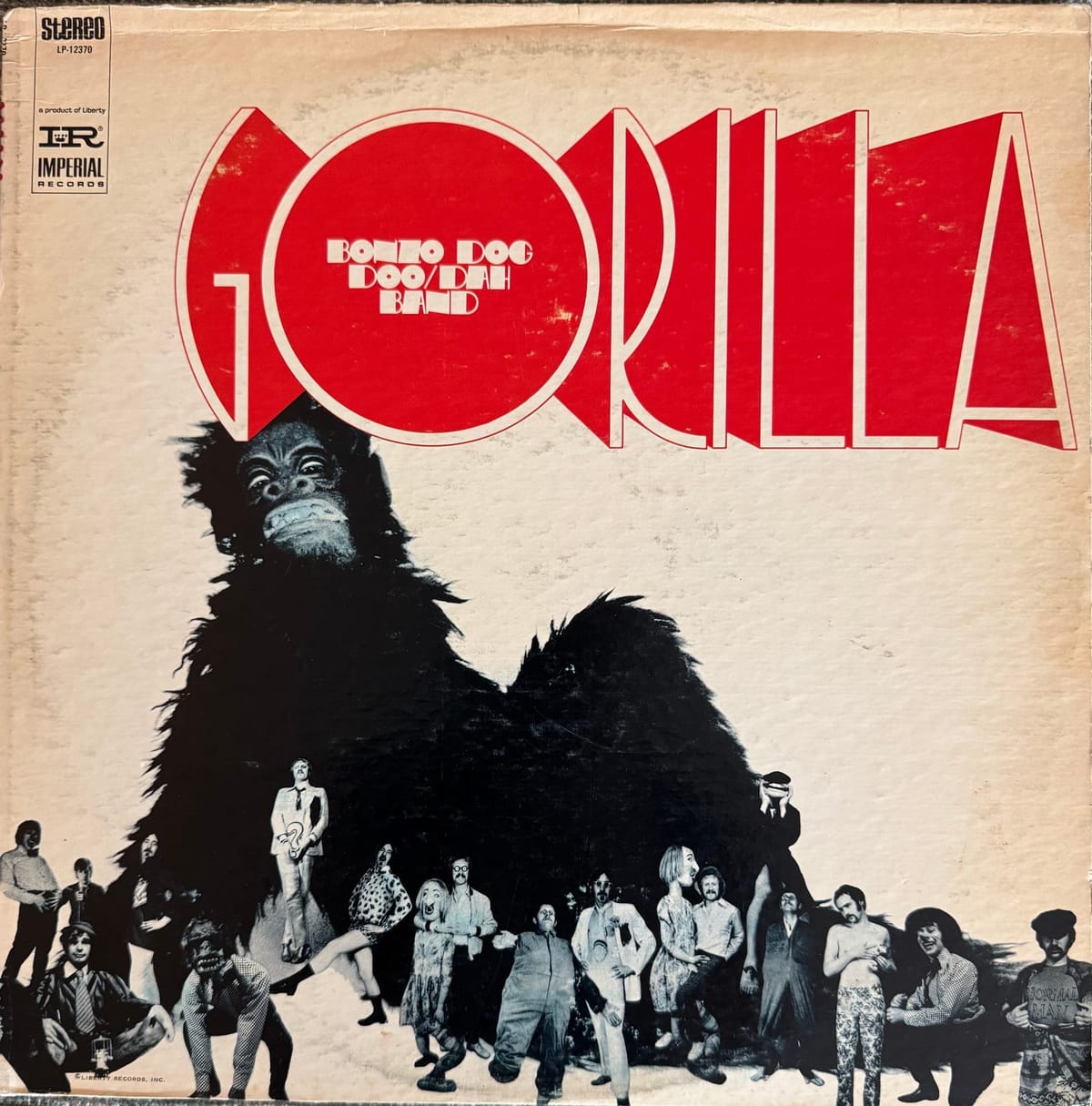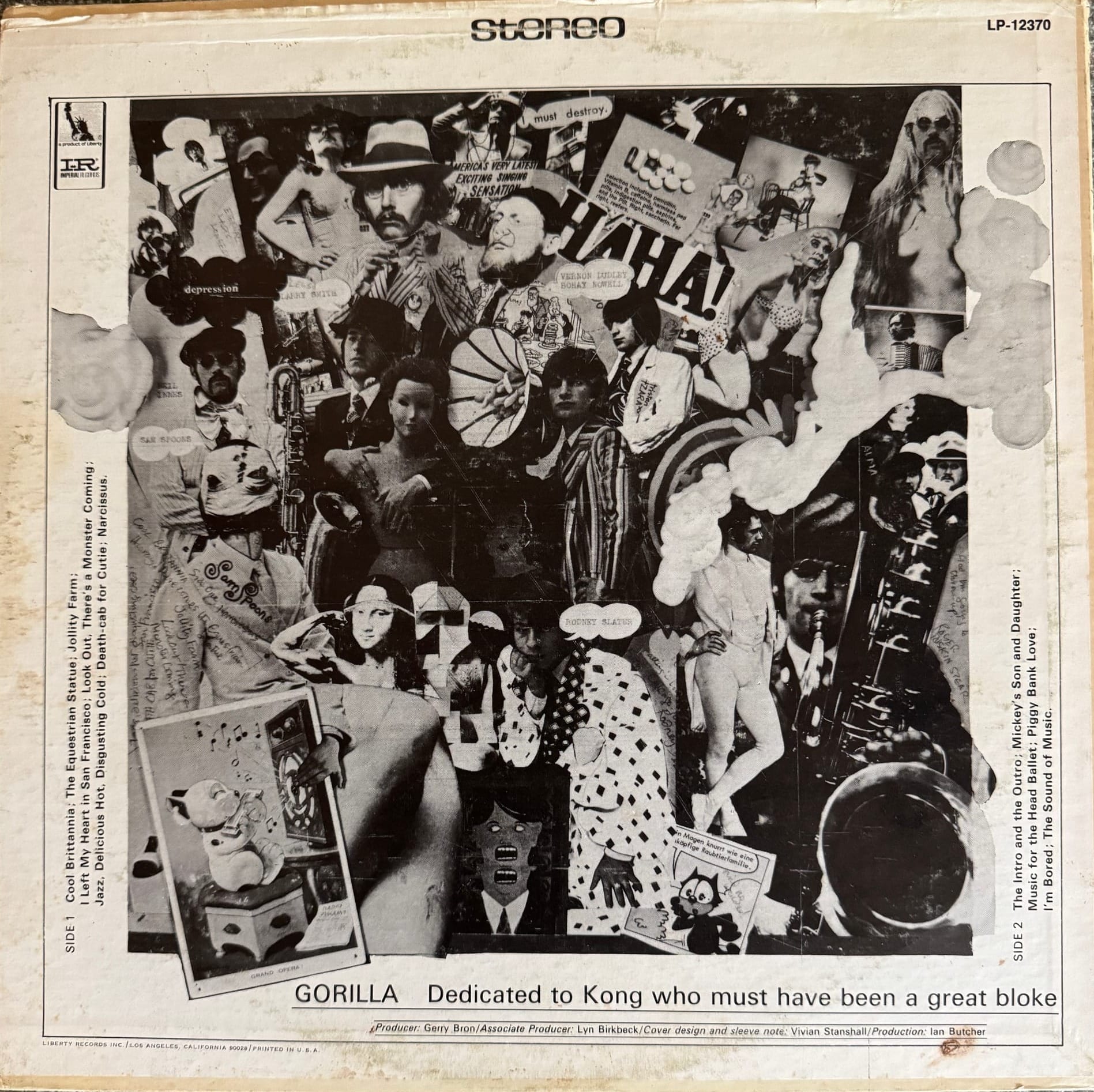Bonzo Dog Doo Dah Band - Gorilla

I’m a strong believer that a gorilla costume improves everything. Sci-fi movie? Stick a space helmet on the gorilla and you’ve got a winner. Theater opening? Yes I want to shake hands with Gonga. To paraphrase and bastardize S.J. Perelman, give me an underground lab, a half-dozen atom smashers, and a person in a gorilla suit menacing a damsel in distress and I care not who writes the nation’s laws.
So I’m already set up to love the Bonzo Dog Doo-Dah Band’s debut album “Gorilla”, because its time-to-gorilla-suit metric is 0 seconds. There’s one right there on the cover. It’s also a strong signifier that one should leave their sense of seriousness, dignity, or traditional good taste at the door. This is a gorilla suit album, and you’re going to get gorilla suit music.
The Bonzos were a bunch of art school weirdos, most notably Neil Innes, who you may remember as Ron Nasty from the Rutles, or possibly as Sir Robin’s chronically cowardly minstrel in Monty Python’s Holy Grail. But they were extremely talented weirdos, with Vivian Stanshall singing and playing a variety of instruments, Rodney Slater providing a whole horn section, and a rotating cast of other jazz cats.
Is Gorilla a jazz album? Yes and no. Is it a comedy album? Maybe? What it is is a glorious paste-up of all the many styles the band was capable of, a series of nigh-parody/nigh-pastiche that’s too good to dismiss as novelty. There’s just about as many styles present as there are songs on the album, although it manages to feel cohesive as an album because all of it desires to skewer tradition and authority.
This is evident from the first track on Side A, “Cool Britannia”, which puts a trad jazz spin on Rule Britannia in an even minute, before devolving into random conversation, and launching into “The Equestrian Statue”, which is sonically a riff on contemporary Kinks material like Dead End Street, while lyrically it lauds the man who comes to clean a stately British statue of man on horse. Jollity Farm is a fairly straightforward take on a 30’s jazz tune, with vaudeville flair, barnyard noises, and ukelele to spare. “Look Out There’s a Monster Coming” is a bizarre calypso take on the pursuit of artificial beauty that feels like the closest thing to a high nail on the record in terms of lack of cohesion. But it’s the next two tracks that make the side for me.
“Jazz: Delicious Hot, Disgusting Cold” is a glorious mess, a jazz track where everyone swaps instruments, intentionally plays raucously and off-kilter, and it still manages to come across as a rollicking good time, like a drunk wedding band at the end of a long night letting loose and seeing what happens. Jazz that feels like it’s about to come off the rails. Inept jazz played by people who are too good to be inept.
“Death-Cab For Cutie” is an Elvis Presley send-up that gave Ben Gibbard the name for his indie darlings. While close to a straight-forward parody of the King, the song is frankly too good to just be parody. If a rockabilly band played this in their set, you wouldn’t blink twice. It’s got spicy love, car accidents, and singable refrains. Someone needs to pick this one up and revive it. Probably not Death Cab for Cutie though.

The beginning of Side B is as close to straight comedy as the album comes. “The Intro and the Outro” starts the side by introducing all of the actual band members, before introducing such luminaries as John Wayne on the xylophone, Adolf Hitler on the vibes, Eric Clapton on the ukulele, Roy Rogers on Trigger, and a number of contemporary references to notable Brit culture that mean nothing to a modern audience (cartoon royalty Lord Snooty, for example). “Mickey’s Son and Daughter” is almost a Disney tune, congratulating Mr. and Mrs. Mouse on the birth of their child. “Music for the Head Ballet” is a disconcerting couple of minutes of wurly that the side could probably do without, but sets the listener just off-kilter enough to prepare them for the run to the end.
“Piggy Bank Love” is a wonderful track, somewhere between American bubblegum and the Beatles at their most poppy. It sounds like a refugee track from the wonderful 80’s bubblegum record “Groovy Neighborhood” by Pianosaurus, and would’ve been completely at home on that record rendered in toy piano and plastic strings. Another song that’s too good to just be parody. Neil Innes would pull this trick again with The Rutles, where his Beatles pastiche was good enough to stand on its own. Heck, I remember the lyrics to “Get Up and Go” better than I do “Get Back”. (Incidentally, I saw The Rutles in a late incarnation in a basement in Brighton, England a number of years ago, and have a delightful memory of singing along to “Good Times Roll” with a number of inebriated Brits while Ron and Barry Wom serenaded us)
The record ends with “I’m Bored”, a rollicking little piece of lyrical fun that sounds like it should be an Innes composition, but is actually Stanshall, running through all the things that leave him cold and bored. There’s a notable callout to “hating every film that Julie Andrews made”, which sets the record up for its actual closer, a total deconstruction of the title track from “The Sound of Music”, taking the hammer to Rodgers and Hammerstein and leaving little standing in their wake.
What does the gorilla suit have to do with any of it? Nothing, I suppose. Except that, as always, the gorilla costume is a mark of campy quality, a sign that you’re in for a good time if you leave your sense of propriety at the door. The Bonzos would go on to have a novelty hit a year or two later with “The Urban Spaceman”, but this record proves that they were more than a novelty act, a bunch of jazz kids who got to stretch out and make something that rode a bicycle on the tightrope between comedy and music and found its balance between the two. While wearing a gorilla suit, no doubt.